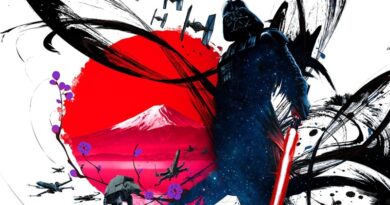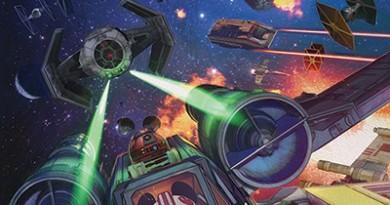Why Branding Matters
I tuned into the August 26th ForceCast last night to have a listen. Jason and Jimmy Mac always make me laugh while sharing a good deal of Star Wars news – and I often do a lot of talking back, to Jason particularly. They had a guest host for the podcast, Kyle Newman, best known to Star Wars fans for his film Fanboys. Within the first few minutes, despite not having show notes on this topic, three huge fans – these are people who are excited about anything Star Wars, who want to like everything Star Wars – digressed into a discussion about the state of the Expanded Universe and the Fate of the Jedi series in particular. I won’t go into the specifics of their discussion, because it pretty much parallels many things I’ve said on this blog previously. It’s worth a listen, for what they say about Fate of the Jedi and then the interesting thoughts about the Blu-rays in the rest of the show. (Most of the specific comments about Fate of the Jedi are during the first fifteen minutes, but they continue to refer back to those points throughout the podcast.) I think Kyle Newman, a storyteller himself, summarized their concerns about Fate of the Jedi best when he noted that the myth of Star Wars is getting lost in the minutiae. That the books aren’t living up to what we expect from Star Wars as a myth or as a brand is exactly what I had intended to post about today.
Where is the Star Wars brand vision in the EU?
If you’ve worked in a large corporate setting, then the term “brand cop” will mean something to you. These are the men and women who send out a friendly reminder when your email signature doesn’t match corporate style, color, and formatting criteria, or who request a copy of your next client presentation to make sure it follows company consistency protocols. Sometimes amid all the color-checking and text-resizing, corporations can lose track of what it is they’re really protecting – the client’s or customer’s perception of the company’s brand. No matter, brand management is recognized as a crucial step in maintaining a successful corporation.
Just this past week, I read a great new book called The Old Rules of Marketing are Dead by Timothy Pearson. It’s been high on the bestsellers list for Amazon and Barnes & Noble, and after checking with a few friends on the marketing side of business it seems this book is supposed to be the next big thing. Pearson’s rules aren’t re-inventing the wheel, but they are very good reminders on how to adapt in this age of the internet, especially in light of the downward turn in the economy. He lists some basic rules for businesses to focus on, then relates them back to failures and successes of major corporations. His first rule is this: The Core is everything.
The core of a brand is its essence. A brand’s core is intangible, and it’s an emotional connection to the consumer or customer based on preferences or experiences.
~pg 29
Looking at the Star Wars brand, what are the intangibles? How has it created an emotional connection to the consumer? And one that has been so longstanding? I asked members of my messageboard to answer specific questions about what Star Wars was to them when they first discovered the franchise, and what it is to them now. For many, the emotional connection began in a movie theater, watching an enormous wedge-shaped spaceship pursue a much tinier craft. Sitting in the cinema, people knew instantly who to root for. By the end, emotions such as anticipation, excitement, and exhilaration rippled through the crowd as the Rebels engaged their attack on the Death Star. Then there was Luke, the lucky shot heard round the galaxy, and we all felt relieved and happy.
Cantina Fan Survey of EU Fans
7) When you think about Star Wars in your earliest fan days, list emotions that best express your experience?
Answers included: wonder, excitement, camaraderie, curiosity, adventurous, hope, thrilling, and fun.
A New Hope was a resounding success, but George Lucas didn’t want to make just one movie – he wanted to make three movies. He had a problem, though, because he worried whether the middle movie could create the same enthusiasm from the fans, enough so he could make the third movie. Ultimately he asked his mentor Irvin Kershner to step in and direct The Empire Strikes Back, and although the tone and direction of the second movie didn’t mirror the first, Kershner brought out new elements – such as romance, spiritual discovery, and ground battles – that helped strengthen the emotional connection fans had with Star Wars.
Over the course of the six movies, the themes and emotions fans experienced in the first two movies have played out repeatedly. Return of the Jedi parallels adventures of both its predecessors on an even grander scale. The Prequel Trilogy presented a more tragic twist to the tales, but every time delivered a hopeful and positive message to end each movie.
Critically, by moving away from this core, companies and enterprises can over time harm and damage their brands and their relationship with their targeted audience – in doing so limiting their potential and sacrificing revenue growth and market opportunities.
~pg 29
In my recent Open Letter to Star Wars I talked about the Star Wars brand and how the last several years of EU books haven’t seemed to be able to channel those elements that fans identify with Star Wars, particularly the emotional connections that were created by the movies and certainly not the myth, like Kyle Newman pointed out. The reason fans return to a franchise’s new products is to recreate, or further develop, the emotions and experiences that drew them to it in the first place. I think the Bioware staff working on The Old Republic showed the most profound respect for this dynamic when they discussed the game’s design at San Diego Comic-Con. The goal of their game is to give each player the experience of being in a Star Wars story that feels like one of the movies – in other words, experiencing those same intense emotional moments over and over again, thus reinforcing what Star Wars is. While TOR players may take a few gutpunches or virtual deaths along the way, the ultimate goal is for each fan to enjoy their experience and celebrate their victories.
8) When you think about Star Wars currently, list emotions that best express how you feel.
Answers included: frustrated, disappointed, apathy, sad, anger, burned fingers, anxiety, and nostalgia.
If you’re a reader of the Expanded Universe books, especially down the post-RotJ timeline, you’ve no doubt experienced numerous emotional gutpunches and quite a few fictional deaths. (For instance, five named characters die in the last few chapters of Ascension.) But if you think about it, when was the last time a book delivered that feeling of catharsis and release we experienced as fans watching A New Hope or Return of the Jedi, or even Revenge of the Sith? The former are purely celebratory, the latter more of a hopeful promise despite the tragedies, but either way we were given uplifting endings that made us feel better about our time spent with Star Wars.
How many fans have experienced the joy of watching true love emerge and blossom in the EU, the way we did with Han and Leia? If you were one of those lucky romantic types who shipped Anakin/Tahiri, Jacen/Tenel Ka, Jacen/Danni, Jaina/Zekk, Jaina/Jag, or Luke/Mara, how has it made you feel to have been dragged around through relationship drudgery, gut-punched a few times, or have it vanish? A pretty large number of fans have walked away from the EU, without the uplifting emotions and cathartic happy endings we expect from Star Wars. Many longtime fans are regarding Ben/Vestara with pessimism, avoiding connection with either character, because there’s little reason to think at this point that it won’t end up as just one more of those doomed EU relationships.
What about mystical hero’s journeys of discovery like we experienced with Luke? How many of those have you read for new characters? Do you still feel that Luke, Han, and Leia are the heroes you grew to love, or are they just a bit too tarnished by the tragedies they’ve suffered and the decisions they’ve made to elicit those old happy memories from the movies when you see their name in print?
[T]he core essence is what makes the brand unique. So as it gets further away from its core, the brand is at risk of losing its differentiation and distinctiveness. That loss makes a brand a commodity – something consumers or customers buy on a price point, not desire. The brand goes from a “have to have” to a “don’t need[.]”
~pg 30
The fact is, Legacy of the Force tried to mirror the Prequel Trilogy, but forgot about the victory parade in Theed, the wedding at the lake house, and the two beautiful scenes with the twins and their new adoptive parents. Those are the scenes and the emotions that gave us hopeful anticipation, even when we knew the darkness was yet to come.
When Fate of the Jedi was announced, fans were given assurances of a lighter story, and even specifically promised there would be no major character deaths for the heroes. Hoping to be given our Star Wars happy endings back in the EU books, many of us wanted very much to believe the FotJ team’s assurances. What we’ve actually seen in the novels, though, is not light or uplifting. Luke and Ben have been off on their odyssey, and while there have been some nice father-son bonding moments, ultimately they’ve been isolated from the rest of their family and friends – in stark opposition to what the lighter movies of Star Wars show. The Jedi, the heroes of Star Wars, have been shunned by politicians and the public in a plotline that calls back to Karen Traviss’s Jedi-hating, and the Galactic Alliance has the instability and irrationality of a banana republic, not a worthy heir to the Rebel Alliance and New Republic. The Sith are back – again – and Ben’s in love with one of them. The ancient evil Abeloth has been tormenting Luke and the Jedi for eight books, yet only one of them ended with an apparent victory for Luke – which was shown to be a false defeat early in the next book. Sure, no one of importance on the heroes’ side has died, but that’s hardly enough to make a story lighter. Where are the positive emotions, the catharsis for the readers and the heroes, and the happy endings? Nowhere to be found – and in large part, I believe that’s why the EU novels are reaching an all-time low in their fan support.
New York Times Bestsellers List for Fate of the Jedi: Ascension’s debut week
Also Selling
16. PORTRAIT OF A SPY, by Daniel Silva, released July 19, 2011
17. A CLASH OF KINGS, by George R. R. Martin, reprinted March 4, 2003
18. CUTTING FOR STONE, by Abraham Verghese, reprinted January 26, 2010
19. THEN CAME YOU, by Jennifer Weiner, released July 12, 2011
20. A STORM OF SWORDS, by George R. R. Martin, reprinted March 4, 2003
21. STATE OF WONDER, by Ann Patchett, released June 7, 2011
22. THE MAGICIAN KING, by Lev Grossman, released August 9, 2011
23. SMOKIN’ SEVENTEEN, by Janet Evanovich, released June 21, 2011
24. SPLIT SECOND, by Catherine Coulter, released July 19, 2011
25. THE GIRL WHO KICKED THE HORNET’S NEST, by Stieg Larsson, released May 25, 2010
26. ROOM, by Emma Donoghue, released May 18, 2011
27. STAR WARS-FATE OF THE JEDI-ASCENSION, by Christie Golden, released August 9, 2011
Somewhere along the way, Del Rey lost sight of the intangible emotional connection that makes Star Wars a must have and turned the books into a don’t need.
The guys on the ForceCast talked briefly about the upcoming Darth Plagueis book. Personally, I’ve always thought Palpatine needed to stay mysterious, and I even agree with Jason that this story may just be too big for the EU. It’s not a must have for me – one too many don’t need Sith or quasi-hero books in a time where people need tales about real heroes – but it’s one of the few I will sit down and read.
Considering the recent success of science fiction and fantasy serial book sales, it’s sad, really, to see so much earning potential and fan enjoyment squandered. It’s possible to tell gritty tales about a universe in constant chaos, yet still leave fans feeling satisfied, even happy, with their fictional journey – with some of the best examples of this coming from Star Wars itself, in the The Clone Wars and the Legacy comics. The books might be nothing more than a side business at Lucasfilm, but I hope the “brand cops” step up to finally enforce the corporate vision. These days, people need tales that gives us a new hope more than ever.
- Hyperspace Theories: Bad Luck Ghorman - June 2, 2025
- Hyperspace Theories: One Year Later as ANDOR Kicks Off Season Two - May 15, 2025
- REVIEW: Tales of the Underworld - May 4, 2025











I like that the “core of a brand is its essence”, but it seems to me that this is a modernizing of an old concept. People have talked for generations about the “heart” of a story – not necessarily a romantic heart, but yes, the core, or center that grounds every tale and makes it accessible, understandable, and familiar.
“Core branding” re-frames that old “heart” point of view into something more accessible in this age of quick-bite storytelling immediacy – and that’s a good thing. From time to time, every important idea needs to be updated for new generations.